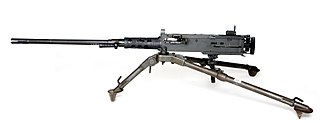
The M2 machine gun or Browning .50 caliber machine gun is a heavy machine gun that was designed near the end of World War I by John Browning. While similar to Browning's M1919 Browning machine gun, which was chambered for the .30-06 cartridge, the M2 uses Browning's larger and more powerful .50 BMG cartridge. The design has had many designations; the official U.S. military designation for the infantry type is Browning Machine Gun, Cal. .50, M2, HB, Flexible. It has been used against infantry, light armored vehicles, watercraft, light fortifications, and low-flying aircraft.

The .50 BMG, also known as 12.7×99mm NATO, and designated as the 50 Browning by the C.I.P., is a .50 in (12.7 mm) caliber cartridge developed for the M2 Browning heavy machine gun in the late 1910s, entering official service in 1921. Under STANAG 4383, it is a standard service cartridge for NATO forces. The cartridge itself has been made in many variants: multiple generations of regular ball, tracer, armor-piercing (AP), incendiary, and saboted sub-caliber penetrator rounds. The rounds intended for machine guns are made into a continuous ammunition belt using metallic links.
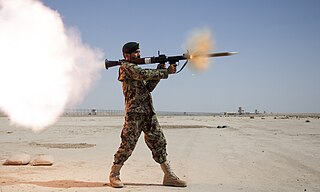
Shoulder-fired missile, shoulder-launched missile or man-portable missile, among other variants, are common slang terms to describe high-caliber shoulder-mounted weapons systems; that is, weapons firing large, heavy projectiles ("missiles"), typically using the backblast principle, which are small enough to be carried by a single person and fired while held on one's shoulder. The word "missile" in this context is used in its original broad sense of a heavy projectile, and encompasses all shells and rockets, guided or unguided. A more formal variant is simply shoulder-fired weapons system and the like.

The Mk 153 Shoulder-Launched Multipurpose Assault Weapon (SMAW) is a smoothbore shoulder-fired rocket launcher. It is a portable assault weapon and has a secondary anti-armor ability. Developed from the B-300, it was introduced to the United States Armed Forces in 1984. Compared to the Israel Military Industries' B-300 weapon that it was developed from, the SMAW has slower projectile velocities, it and its ammunition are both heavier, and it takes a second crew member to keep up with the B-300's rate-of-fire, but some of its projectile options have longer ranges than the B-300.
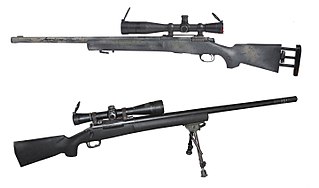
A sniper rifle is a high-precision, long-range rifle. Requirements include high accuracy, reliability, and mobility, concealment, and optics, for anti-personnel, anti-materiel and surveillance uses by military snipers. The modern sniper rifle is a portable shoulder-fired rifle with either a bolt action or semi-automatic action, fitted with a telescopic sight for extreme accuracy and chambered for a high-ballistic performance centerfire cartridge.
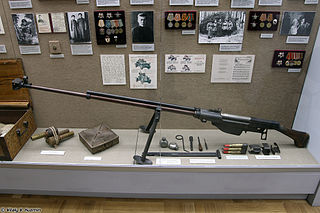
An anti-tank rifle is an anti-materiel rifle designed to penetrate the armor of armored fighting vehicles, most commonly tanks, armored personnel carriers, and infantry fighting vehicles. The term is usually used for weapons that can be carried and used by one person, but is sometimes used for larger weapons. The usefulness of rifles for this purpose ran from the introduction of tanks in World War I until the Korean War. While medium and heavy tank armor became too thick to be penetrated by rigid projectiles from rifles that could be carried by a single soldier, anti-tank rifles continued to be used against other "soft" targets, though recoilless rifles and rocket-propelled grenades such as the bazooka were also introduced for infantry close-layer defense against tanks.
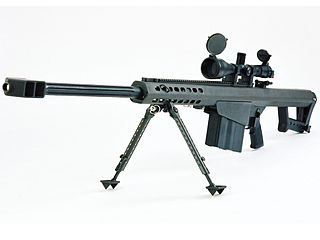
An anti-materiel rifle (AMR) is a rifle designed for use against military equipment, structures, and other hardware (materiel) targets. Anti-materiel rifles are chambered in significantly larger calibers than conventional rifles and are employed to eliminate equipment such as engines and unarmored or lightly armored targets. Although not originally designed for use against human targets, the bullet weight and velocity of anti-materiel rifles gives them exceptional long-range capability even when compared with designated sniper rifles. Anti-materiel rifles are made in both bolt-action as well as semi-automatic designs.

The Maschinengewehr (MG) 151 is a belt-fed autocannon for aircraft use, developed in Nazi Germany from 1934 to 1940 and produced by Waffenfabrik Mauser during World War II. It was originally produced in 15.1 mm caliber from 1940, with a 15×96mm cartridge, but due to demand for higher effect against aircraft, especially with the introduction of mine shells for the 20 mm MG-FF/M aircraft cannon, the design was rechambered to 20 mm caliber in 1941, using a newly developed 20×82mm cartridge which traded projectile velocity for explosive power. The initial 15 mm variant then became known as the MG 151/15, with the new 20 mm variant becoming the MG 151/20.

The Barrett XM109, originally known as the Objective Sniper Weapon (OSW) and now called the Anti-Materiel Payload Rifle (AMPR), is a prototype anti-materiel sniper rifle. It is chambered for 25 × 59 mm grenade rounds and was developed by Barrett Firearms Manufacturing. It was designed in accordance with a requirement set out in 1994, and is capable of defeating light armor and equipment out to 2 km.

The 30 mm caliber is a range of autocannon ammunition. It includes the NATO standardized Swiss 30×173mm, the Soviet 30×155mmB, 30×165mm and 30×210mmB, the Czechoslovak 30×210mm, the Yugoslav 30×192mm, the British 30×113mmB, and the French 30×150mmB and 30×170mm cartridges.
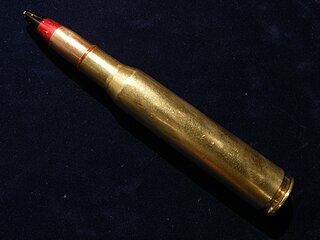
The 12.7×108mm cartridge is a 12.7 mm heavy machine gun and anti-materiel rifle cartridge used by the former Soviet Union and Warsaw Pact countries, including Russia, China, Iran, North Korea, and many others. It was invented in 1934 to create a cartridge like the German 13.2mm TuF anti-tank rifle round and the American .50 Browning Machine Gun round.

The Barrett M82 is a recoil-operated, semi-automatic anti-materiel rifle developed by the Australian-owned company Barrett Firearms Manufacturing and produced in the United States.
20 mm caliber is a specific size of popular autocannon ammunition. The dividing line between smaller-caliber weapons, commonly called "guns", from larger-caliber "cannons", is conventionally taken to be the 20 mm round, the smallest caliber of autocannon. All 20 mm cartridges have an outside projectile (bullet) diameter and barrel bore diameter of approximately 0.787 inches (20.0 mm). These projectiles are typically 75 to 127 mm (3–5 in) long, cartridge cases are typically 75 to 152 mm (3–6 in) long, and most are shells, with an explosive payload and detonating fuze.

The 14.5×114mm is a heavy machine gun and anti-materiel rifle cartridge used by the Soviet Union, the former Warsaw Pact, modern Russia, and other countries.
In warfare, high-explosive incendiary (HEI) is a type of ammunition specially designed to impart energy and therefore damage to its target in one or both of two ways: via a high-explosive charge and/or via its incendiary (fire-causing) effects. Each round has both capabilities.

High-explosive incendiary/armor-piercing ammunition (HEIAP) is a form of shell which combines armor-piercing capability and a high-explosive effect. In this respect it is a modern version of an armor-piercing shell. The ammunition may also be called semi-armor-piercing high-explosive incendiary (SAPHEI).

The Raufoss Mk 211 is a .50 BMG multi-purpose anti-materiel high-explosive incendiary/armor-piercing ammunition projectile produced by Nammo under the model name NM140 MP. It is commonly referred to as multipurpose or Raufoss, meaning red waterfall in Norwegian. This refers to Nammo's precursor company Raufoss Ammunisjonsfabrikker, an ammunition manufacturer established 1896 in Raufoss, Norway. The "Mk 211" name comes from the nomenclature Mk 211 Mod 0 used by the U.S. military for this round.
Nammo, short for Nordic Ammunition Company, is a Norwegian-Finnish aerospace and defence group specialized in production of ammunition, rocket engines and space applications. The company has subsidiaries in Finland, Germany, Norway, Sweden, Switzerland, Spain, the United Kingdom, the Republic of Ireland, and the United States. The company ownership is evenly split between the Norwegian government and the Finnish defence company Patria. The company has its headquarters in Raufoss, Norway.















